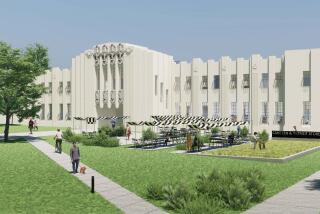Line Drawn on Sacred Ground
WASHINGTON — In an echo of controversies from years past, veterans groups are sharply divided on whether the Tomb of the Unknowns should be opened to determine if Vietnam-era remains are those of a downed Air Force pilot.
As the Pentagon considers whether to disturb the revered site, the American Legion and the Veterans of Foreign Wars are recommending that the government move cautiously before testing the remains to see if they belong to Air Force 1st Lt. Michael J. Blassie, as his family and some activists believe. But these groups’ newer brother, the Vietnam Veterans of America, is urging a swift examination and quick resolution of the issue.
The emerging division is likely to make the Pentagon’s sensitive decision all the more agonizing. And it mirrors differences among veterans in the 1970s and 1980s, when controversy swirled around the Carter and Reagan administrations’ efforts to find and inter an officially unknown Vietnam-era vet at the Arlington National Cemetery site to help heal the war’s wounds.
The question of whether to open the crypt emerged this week, with Blassie’s family members saying they believe evidence collected after Blassie was shot down strongly indicates that the remains are his.
In 1972, South Vietnamese reconnaissance troops collected human bones, two ID cards with Blassie’s name and other items after the Missouri-born flier was shot down at An Loc, about 60 miles north of Saigon.
The remains weren’t sufficient to provide positive identification of Blassie at the time, but because of advances in DNA testing, some analysts believe a test could now conclusively determine whether the remains are Blassie’s.
Sara Bernasconi, an official of the Vietnam Veterans of America’s POW-MIA committee, said identification of remains should be the top priority, and noted that President Clinton himself has made such efforts a top national goal.
“I definitely think the tomb should be opened,” said Bernasconi of Albuquerque, whose husband was declared missing in action. “We would be terribly remiss if we didn’t bring some resolution and peace to a veteran’s family.”
Bernasconi said she would have “no hesitation” about disturbing the site, though it is considered by some to be the nation’s most sacred ground. The need to bring service members “home to their rightful place is sacred too,” she said.
There is no apparent disagreement among members of her group on the issue, she added.
At the American Legion, the largest veteran’s group, officials reacted cautiously. Spokesman Phil Budahn said the group was urging Congress and the Pentagon to take a careful and “dispassionate” look at the issue.
Though the government has a “moral obligation to do all it can” to identify the remains of service members, Budahn said, the group was “not absolutely sure at this point that the evidence warrants that.”
It is “a major emotional action to open up that tomb, and it ought not to be done unless we’re very sure that there’s no other way to resolve the issue,” Budahn said.
Kenneth Steadman, executive director of the VFW’s Washington office, said the question was a “real tough one” because of conflicting desires to honor the sanctity of the tomb and to support the family’s desires to know if the remains belong to the pilot.
If there is “compelling and substantial evidence” that the remains belong to Blassie, the VFW would support opening the tomb, he said.
Differences among the veterans groups were often sharp during the 11 years that the federal government sought to arrange the burial of an “unknown” Vietnam veteran in the white marbled tomb across the Potomac from Washington.
Congress passed legislation in 1973 calling for entombment of a Vietnam-era veteran’s remains. As years passed, some members of Congress and veteran’s groups increasingly pressed to find remains to be buried next to the unknowns of World War I, World War II and the Korean War.
The VFW and some other groups argued that the gesture would help close the lingering wounds of Vietnam. But groups representing POWs and MIAs, including the National League of Families, argued that burying the remains of an unknown could undermine the government’s interest in finding out what happened to those whose disappearance was still unexplained.
These conflicting views whipsawed the Carter and Reagan administrations. And in 1984, when a set of remains was finally interred--in a ceremony overseen by Reagan himself--some veterans charged that the administration was covering up its knowledge of the service member’s identity in a politically motivated effort to finish the job.
The allegation has been raised anew because of the Blassie family’s claim. The Pentagon, which denied that there was a cover-up at the time, denies it again today.
More to Read
Sign up for Essential California
The most important California stories and recommendations in your inbox every morning.
You may occasionally receive promotional content from the Los Angeles Times.











